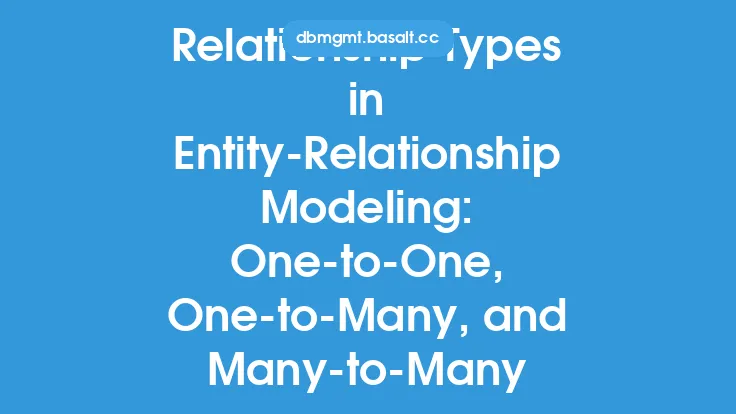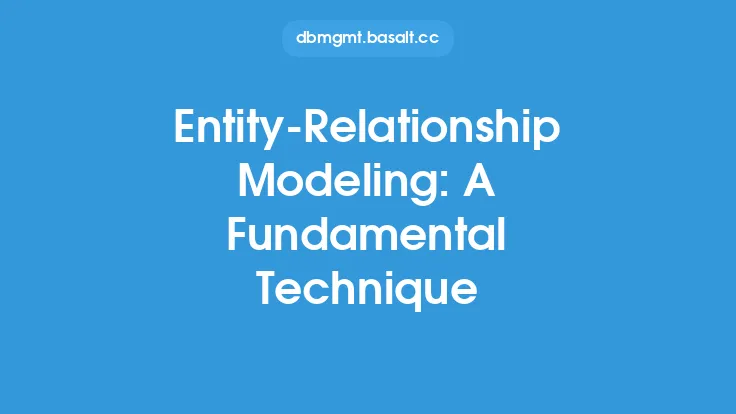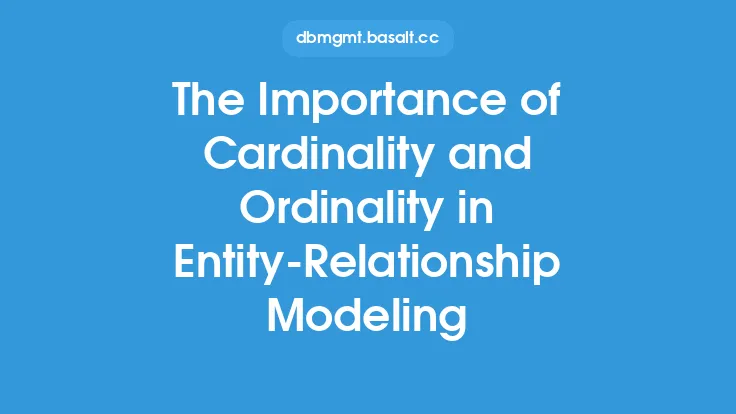Entity-Relationship Modeling (ERM) is a fundamental concept in database design that helps to create a conceptual representation of the data and its relationships. It is a powerful tool used to design and implement databases, and its importance cannot be overstated. ERM provides a way to model the structure of a database, including the entities, attributes, and relationships between them. In this article, we will delve into the world of ERM, exploring its key components, benefits, and applications.
Introduction to Entity-Relationship Modeling
Entity-Relationship Modeling is a methodology that was first introduced by Peter Chen in 1976. It is based on the idea that a database can be represented as a collection of entities, attributes, and relationships. An entity is an object or concept that has an independent existence, such as a customer, order, or product. An attribute is a characteristic or property of an entity, such as a customer's name or address. A relationship is a connection between two or more entities, such as a customer placing an order.
Key Components of Entity-Relationship Modeling
There are several key components of ERM, including entities, attributes, and relationships. Entities are the core components of a database, and they can be either strong or weak. A strong entity is one that has a unique identifier, such as a customer ID, while a weak entity is one that relies on another entity for its existence, such as an order item. Attributes are the characteristics or properties of an entity, and they can be either simple or composite. Simple attributes are single values, such as a customer's name, while composite attributes are made up of multiple values, such as a customer's address.
Benefits of Entity-Relationship Modeling
ERM provides several benefits, including improved data integrity, reduced data redundancy, and improved scalability. By modeling the structure of a database, ERM helps to ensure that the data is consistent and accurate. It also helps to reduce data redundancy by identifying and eliminating duplicate data. Additionally, ERM makes it easier to scale a database, as it provides a clear understanding of the relationships between entities.
Applications of Entity-Relationship Modeling
ERM has a wide range of applications, including database design, data warehousing, and business intelligence. It is used in a variety of industries, including finance, healthcare, and e-commerce. ERM is also used in data modeling, which is the process of creating a conceptual representation of the data. Data modeling is an essential step in the database design process, as it helps to ensure that the database is designed to meet the needs of the users.
Entity-Relationship Modeling and Database Design
ERM is a critical component of database design, as it provides a way to model the structure of a database. Database design is the process of creating a database that meets the needs of the users, and ERM is an essential step in this process. By using ERM, database designers can create a database that is scalable, flexible, and easy to maintain. ERM also helps to ensure that the database is designed to support the business requirements of the organization.
Entity-Relationship Modeling and Data Analysis
ERM is also used in data analysis, which is the process of extracting insights and patterns from data. Data analysis is an essential step in the decision-making process, as it helps to identify trends and patterns in the data. ERM provides a way to model the structure of the data, which makes it easier to analyze and extract insights. By using ERM, data analysts can create a conceptual representation of the data, which helps to identify relationships and patterns.
Conclusion
In conclusion, Entity-Relationship Modeling is a fundamental concept in database design that provides a way to model the structure of a database. It is a powerful tool used to design and implement databases, and its importance cannot be overstated. ERM provides several benefits, including improved data integrity, reduced data redundancy, and improved scalability. It has a wide range of applications, including database design, data warehousing, and business intelligence. By using ERM, database designers and data analysts can create a database that is scalable, flexible, and easy to maintain, and extract insights and patterns from the data.





